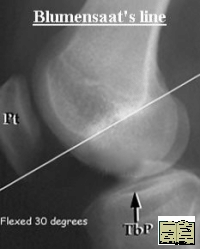Patella height
There are three ways to measure patella height (knee needs to be slightly flexed about 30 degrees to tension extensor mechanism)
 |
1. Blumensaat's lineWith the knee flexed 30 degrees a line drawn through the roof of the intercondylar notch should touch the tip of the patella. NOT VERY RELIABLE 2. Insall Salvati indexLength of Patella (LP) / Length of Patella tendon (LT) LP/LT = 1 (Standard deviation 0.13) 3. Blackburn and PeelUseful if not sure where tibial tuberosity is, ie. old Osgood Schlaters disease.
Lateral radiograph, knee flexed at least 30º. Project a line forwards along the tibial plateau and make two measurements:
|
References
Blumensaat, C. (1938) Die Lageabweichungen und Verrenkungen der Kniescheibe. Ergebnisse der Chirurgie und Orthop#{228}die, 31, 149-223.
Insall, J., and Salvati, E. (1971) Patella position in the normal knee joint.
Radiology, 101, 101-104.
JS Blackburne and TE Peel; A new method of measuring patellar height; J Bone Joint Surg Br, May 1977; 59-B: 241 - 242